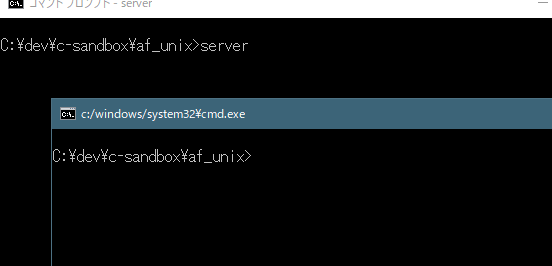AF_UNIX comes to Windows – Windows Command Line Tools For Developers
Introduction: Beginning in Insider Build 17063 , you’ll be able to use the unix socket ( AF_UNIX )...
https://blogs.msdn.microsoft.com/commandline/2017/12/19/af_unix-comes-to-windows/
昨日、Windows 10 April 2018 Update が来た。WSL (Windows Subsystem for Linux) の常駐もちゃんと動く様になってた。仕組みはどうやら WSL 上のプロセスが一つでも生きていればバックグラウンドで Ubuntu.exe が生き続けてくれるという物らしい。WSL でも tmux が問題なく使える様になって開発しやすくなった。
ところでこの Windows 10 April 2018 Update には、開発者が待ちに待った Windows での AF_UNIX 対応が入っている。つまりは UNIX Domain Socket が Windows で動く様になったという事だ。物は試しと簡単なプログラムを作ってみた。
#ifdef _WIN32
# include <ws2tcpip.h>
# include <io.h>
#else
# include <sys/fcntl.h>
# include <sys/types.h>
# include <sys/socket.h>
# include <netinet/in.h>
# include <netdb.h>
# define closesocket(fd) close(fd)
#endif
#include <stdio.h>
#define UNIX_PATH_MAX 108
typedef struct sockaddr_un {
ADDRESS_FAMILY sun_family;
char sun_path[UNIX_PATH_MAX];
} SOCKADDR_UN, *PSOCKADDR_UN;
int
main(int argc, char* argv[]) {
int server_fd;
int client_fd;
struct sockaddr_un server_addr;
size_t addr_len;
#ifdef _WIN32
WSADATA wsa;
WSAStartup(MAKEWORD(2, 2), &wsa);
#endif
unlink("./server.sock");
if ((server_fd = socket(AF_UNIX, SOCK_STREAM, 0)) < 0) {
perror("server: socket");
exit(1);
}
memset((char *) &server_addr, 0, sizeof(server_addr));
server_addr.sun_family = AF_UNIX;
strcpy(server_addr.sun_path, "./server.sock");
if (bind(server_fd, (struct sockaddr *)&server_addr, sizeof(server_addr)) < 0) {
perror("server: bind");
exit(1);
}
if (listen(server_fd, 5) < 0) {
perror("server: listen");
closesocket(server_fd);
exit(1);
}
while (1) {
if ((client_fd = accept(server_fd, NULL, NULL)) < 0) {
perror("server: accept");
break;
}
while (1) {
char buf[256];
int n = recv(client_fd, buf, sizeof(buf), 0);
if (n <= 0) break;
buf[n] = 0;
puts(buf);
}
closesocket(client_fd);
}
closesocket(server_fd);
#ifdef _WIN32
WSACleanup();
#endif
}
普通のソケットプログラムだ。mingw のヘッダには sockaddr_un の定義が無いので冒頭で宣言している。Visual Studio だと afunix.h というヘッダが入るはず。Windows はソケットディスクリプタに対して read/write/close が動作しないのはこれまで通りだった。次にクライアントのコード。
#ifdef _WIN32
# include <ws2tcpip.h>
# include <io.h>
#else
# include <sys/fcntl.h>
# include <sys/types.h>
# include <sys/socket.h>
# include <netinet/in.h>
# include <netdb.h>
# define closesocket(fd) close(fd)
#endif
#include <stdio.h>
#define UNIX_PATH_MAX 108
typedef struct sockaddr_un {
ADDRESS_FAMILY sun_family;
char sun_path[UNIX_PATH_MAX];
} SOCKADDR_UN, *PSOCKADDR_UN;
int
main(int argc, char* argv[]) {
int client_fd;
struct sockaddr_un client_addr;
#ifdef _WIN32
WSADATA wsa;
WSAStartup(MAKEWORD(2, 2), &wsa);
#endif
if ((client_fd = socket(AF_UNIX, SOCK_STREAM, 0)) < 0) {
perror("server: socket");
exit(1);
}
memset((char *) &client_addr, 0, sizeof(client_addr));
client_addr.sun_family = AF_UNIX;
strcpy(client_addr.sun_path, "./server.sock");
if (connect(client_fd, (struct sockaddr *)&client_addr, sizeof(client_addr)) < 0) {
perror("client: connect");
exit(1);
}
while (1) {
char buf[256];
if (!fgets(buf, sizeof(buf), stdin))
break;
char *p = strpbrk(buf, "\r\n");
if (p) *p = 0;
if (send(client_fd, buf, strlen(buf), 0) < 0)
break;
}
closesocket(client_fd);
#ifdef _WIN32
WSACleanup();
#endif
}
こちらも至って普通のコード。一応 UNIX でもコンパイル出来る様にしたつもりだけど、試してはない。
mingw でも問題なくコンパイルして動作する様になったし、実行は Cygwin も msys2 も WSL も必要なく動作した。Windows 10 でしか動作しないので、しばらくは OSS で使われる事はないだろうけど、UAC の画面も開かないので個人的には便利だと思う。今後は Windows 版の nginx がリバースプロキシ対応したりするんじゃないかと思う。







